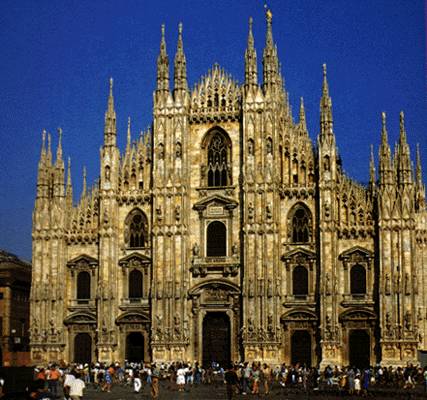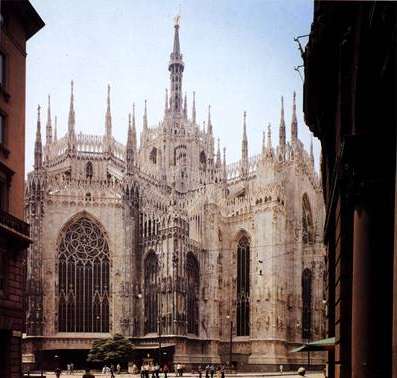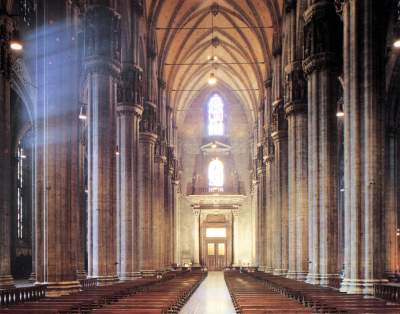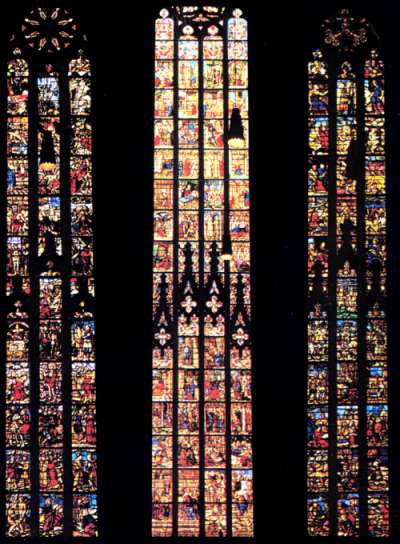Few churches in ltaly underwent such a slow, complex building process as Milan's cathedral.

In addition, putting up such a gigantic monument involved not only Lombardy but actually all
of Italy. It was, in fact, through the cathedral that the High Gothic style from beyond the
Alps made its way down to Milan and henceforth influenced the whole country. Progress was
painstakingly slow: work actually went on throughout five centuries, although the original
Gothic style was never abandoned. The cathedral, dedicated to Mary, was actually begun in
1387 over the site of the 9
th century basilica of
St. Maria Maggiore.
Built on the express wish of Archbishop
Antonio da Saluzzo, the initiative found
favor with
Gian Galeazzo Visconti (then ruler of the city) and the whole MiIanese
population. For that year the chief engineer was
Simone da Orsegnigo who was aided
by several Campionese (Swiss) masons. Nevertheless, the overall design of the cathedral
was undoubtedly conceived by a sole mastermind, an artist definitely from beyond the Alps
since, despite the fact that numerous architects had a hand in it, the cathedral never lost
its amazing cohesiveness - a characteristic so typical of the work of Northern masters. It
must be said, however, that the Gothic schemes in the hands of the Italian architects lost

much of their Northern flavor and acquired a more typically Italian feeling. Simone da
Orsenigo was, surrounded by a crew of great stonemasons:
Marco "de Frixeno" of Campione,
Matteo da Campione, and greatest of all,
Giovannino de' Grassi. In 1389 da
Orsenigo was dismissed and
Nicola di Bonaventura was summoned from Paris. Nicola
designed the huge pierced windows of the apse after his arrival in Milan on May 7, 1389 but
he too was dismissed (on July 31 , 1390). Italian and foreign master craftsmen followed one
another; amog them we may cite the Germans
Johann from Freiburg,
Heinrich Parler
from Gmunden,
Ulrich from Fussingen,
Hans von Fernach, and the Italians
Bernardo da Venezia,
Gabriele Stornaloco,
Marco da Carona, Giovannino
de' Grassi and
Giacomo da Campione. The latter two worked permanently in the cathedral
workshop from 1392 on and left their imprint in the use of the so-called "
Fowery Gothic"
style known for its flamboyant decorative patterns. After the death of the great masterster
de' Grassi, the Parisan
Jean Mignot, sharply critical of what had been previously done,
was put in charge, but opposed by Bernardo da Venezia and
Bertolino da Novara, he was
soon fired, and from then on the building of the Cathedral of Milan was supervised exclusively

by Italian masters. In 1400
Filippino degli Ugoni became supervisor of the project;
the capitals, vaulting, and terraces are of his design. Work went on at such a fast pace
that by 14I8 the main altar could be cousecrated by Pope
Martin V. When
Francesco
Sforza came to power in the mid 15
th century, art in Milan was absorbing French
and Tuscan influences. 15
th century Milanese architecture and thus also that of
the cathedral was strotigly influenced by three generations of the Solari family:
Giovanni
Solari, his son
Guinforte, and Guinforte's son
Pier Antonio. Guinforte's
son-in-law', the great
Giovanni Antonio Amadeo, won the competition called in 1490
for the building of the drum. Despite the new Renaissance turn art had taken, Amadeo was a
strenuous defender of the structure's Gothic unity. He completed the drum by 1500. Ten
years later the first of the four adjacent spires was put up it too in the Gothic style.
Meanwhile the great surge of "
Flowery Gothic" was gradually losing momentum, beaten
by the new more plastic treatment of form advocated by
Filarete,
Luca Francelli,
Francesco di Giorgi, and
Leonardo, summoned from all over Italy to give

fresh advice and up-to-date opinions on how the cathedral should be built. After a brief
German intervention, a master called by
Gian Galeazzo Sforza from Strasburg in 1482,
Pellegrino Pellegrini, also known as Tibaldi, the favorite architect of Archbishop
Carlo Borromeo, was named mastermason. Pellegrini immediately threw himself into
the job and designed the patterns for the flooring and choir stalls. In 1572 Borromeo
reconsecrated the cathedral. In 1585, when Pellegrini left for Spain, he got
Martino
Bassi and then later
Lelio Buzzi, who had earlier designed the Ambrosian Library,
to take over. When the other great
Borromeo, Federico, was Archbishop,
Fabio
Mangoni was put in charge of the cathedral building, followed by
Richini and
the
Quadrio, but the 18
th century was ushered in and it was still incomplete. The
great spire was erected between 1765 and 1769 and the fašade, based on Pellegrini's idea,
was put up between 1815 and 1813. Work went on right through the 19
th century,
during which time the spires and the towers with stairways inside were completed. The whole
complex construction, however, was badly in need of restoration: the first campaign was
undertaken in 1935 and the second - even more complicated and painful - after the bombardments
of 1943. During the latter restoration project, the flooring was restored and the statues
and decorative elements which had suffered the greatest war damage were replaced. Finally,
on December 8, 1966, the new churchyard was dedicated.

 In addition, putting up such a gigantic monument involved not only Lombardy but actually all
of Italy. It was, in fact, through the cathedral that the High Gothic style from beyond the
Alps made its way down to Milan and henceforth influenced the whole country. Progress was
painstakingly slow: work actually went on throughout five centuries, although the original
Gothic style was never abandoned. The cathedral, dedicated to Mary, was actually begun in
1387 over the site of the 9th century basilica of St. Maria Maggiore.
Built on the express wish of Archbishop Antonio da Saluzzo, the initiative found
favor with Gian Galeazzo Visconti (then ruler of the city) and the whole MiIanese
population. For that year the chief engineer was Simone da Orsegnigo who was aided
by several Campionese (Swiss) masons. Nevertheless, the overall design of the cathedral
was undoubtedly conceived by a sole mastermind, an artist definitely from beyond the Alps
since, despite the fact that numerous architects had a hand in it, the cathedral never lost
its amazing cohesiveness - a characteristic so typical of the work of Northern masters. It
must be said, however, that the Gothic schemes in the hands of the Italian architects lost
In addition, putting up such a gigantic monument involved not only Lombardy but actually all
of Italy. It was, in fact, through the cathedral that the High Gothic style from beyond the
Alps made its way down to Milan and henceforth influenced the whole country. Progress was
painstakingly slow: work actually went on throughout five centuries, although the original
Gothic style was never abandoned. The cathedral, dedicated to Mary, was actually begun in
1387 over the site of the 9th century basilica of St. Maria Maggiore.
Built on the express wish of Archbishop Antonio da Saluzzo, the initiative found
favor with Gian Galeazzo Visconti (then ruler of the city) and the whole MiIanese
population. For that year the chief engineer was Simone da Orsegnigo who was aided
by several Campionese (Swiss) masons. Nevertheless, the overall design of the cathedral
was undoubtedly conceived by a sole mastermind, an artist definitely from beyond the Alps
since, despite the fact that numerous architects had a hand in it, the cathedral never lost
its amazing cohesiveness - a characteristic so typical of the work of Northern masters. It
must be said, however, that the Gothic schemes in the hands of the Italian architects lost
 much of their Northern flavor and acquired a more typically Italian feeling. Simone da
Orsenigo was, surrounded by a crew of great stonemasons: Marco "de Frixeno" of Campione,
Matteo da Campione, and greatest of all, Giovannino de' Grassi. In 1389 da
Orsenigo was dismissed and Nicola di Bonaventura was summoned from Paris. Nicola
designed the huge pierced windows of the apse after his arrival in Milan on May 7, 1389 but
he too was dismissed (on July 31 , 1390). Italian and foreign master craftsmen followed one
another; amog them we may cite the Germans Johann from Freiburg, Heinrich Parler
from Gmunden, Ulrich from Fussingen, Hans von Fernach, and the Italians
Bernardo da Venezia, Gabriele Stornaloco, Marco da Carona, Giovannino
de' Grassi and Giacomo da Campione. The latter two worked permanently in the cathedral
workshop from 1392 on and left their imprint in the use of the so-called "Fowery Gothic"
style known for its flamboyant decorative patterns. After the death of the great masterster
de' Grassi, the Parisan Jean Mignot, sharply critical of what had been previously done,
was put in charge, but opposed by Bernardo da Venezia and Bertolino da Novara, he was
soon fired, and from then on the building of the Cathedral of Milan was supervised exclusively
much of their Northern flavor and acquired a more typically Italian feeling. Simone da
Orsenigo was, surrounded by a crew of great stonemasons: Marco "de Frixeno" of Campione,
Matteo da Campione, and greatest of all, Giovannino de' Grassi. In 1389 da
Orsenigo was dismissed and Nicola di Bonaventura was summoned from Paris. Nicola
designed the huge pierced windows of the apse after his arrival in Milan on May 7, 1389 but
he too was dismissed (on July 31 , 1390). Italian and foreign master craftsmen followed one
another; amog them we may cite the Germans Johann from Freiburg, Heinrich Parler
from Gmunden, Ulrich from Fussingen, Hans von Fernach, and the Italians
Bernardo da Venezia, Gabriele Stornaloco, Marco da Carona, Giovannino
de' Grassi and Giacomo da Campione. The latter two worked permanently in the cathedral
workshop from 1392 on and left their imprint in the use of the so-called "Fowery Gothic"
style known for its flamboyant decorative patterns. After the death of the great masterster
de' Grassi, the Parisan Jean Mignot, sharply critical of what had been previously done,
was put in charge, but opposed by Bernardo da Venezia and Bertolino da Novara, he was
soon fired, and from then on the building of the Cathedral of Milan was supervised exclusively
 by Italian masters. In 1400 Filippino degli Ugoni became supervisor of the project;
the capitals, vaulting, and terraces are of his design. Work went on at such a fast pace
that by 14I8 the main altar could be cousecrated by Pope Martin V. When Francesco
Sforza came to power in the mid 15th century, art in Milan was absorbing French
and Tuscan influences. 15th century Milanese architecture and thus also that of
the cathedral was strotigly influenced by three generations of the Solari family: Giovanni
Solari, his son Guinforte, and Guinforte's son Pier Antonio. Guinforte's
son-in-law', the great Giovanni Antonio Amadeo, won the competition called in 1490
for the building of the drum. Despite the new Renaissance turn art had taken, Amadeo was a
strenuous defender of the structure's Gothic unity. He completed the drum by 1500. Ten
years later the first of the four adjacent spires was put up it too in the Gothic style.
Meanwhile the great surge of "Flowery Gothic" was gradually losing momentum, beaten
by the new more plastic treatment of form advocated by Filarete, Luca Francelli,
Francesco di Giorgi, and Leonardo, summoned from all over Italy to give
by Italian masters. In 1400 Filippino degli Ugoni became supervisor of the project;
the capitals, vaulting, and terraces are of his design. Work went on at such a fast pace
that by 14I8 the main altar could be cousecrated by Pope Martin V. When Francesco
Sforza came to power in the mid 15th century, art in Milan was absorbing French
and Tuscan influences. 15th century Milanese architecture and thus also that of
the cathedral was strotigly influenced by three generations of the Solari family: Giovanni
Solari, his son Guinforte, and Guinforte's son Pier Antonio. Guinforte's
son-in-law', the great Giovanni Antonio Amadeo, won the competition called in 1490
for the building of the drum. Despite the new Renaissance turn art had taken, Amadeo was a
strenuous defender of the structure's Gothic unity. He completed the drum by 1500. Ten
years later the first of the four adjacent spires was put up it too in the Gothic style.
Meanwhile the great surge of "Flowery Gothic" was gradually losing momentum, beaten
by the new more plastic treatment of form advocated by Filarete, Luca Francelli,
Francesco di Giorgi, and Leonardo, summoned from all over Italy to give
 fresh advice and up-to-date opinions on how the cathedral should be built. After a brief
German intervention, a master called by Gian Galeazzo Sforza from Strasburg in 1482,
Pellegrino Pellegrini, also known as Tibaldi, the favorite architect of Archbishop
Carlo Borromeo, was named mastermason. Pellegrini immediately threw himself into
the job and designed the patterns for the flooring and choir stalls. In 1572 Borromeo
reconsecrated the cathedral. In 1585, when Pellegrini left for Spain, he got Martino
Bassi and then later Lelio Buzzi, who had earlier designed the Ambrosian Library,
to take over. When the other great Borromeo, Federico, was Archbishop, Fabio
Mangoni was put in charge of the cathedral building, followed by Richini and
the Quadrio, but the 18th century was ushered in and it was still incomplete. The
great spire was erected between 1765 and 1769 and the fašade, based on Pellegrini's idea,
was put up between 1815 and 1813. Work went on right through the 19th century,
during which time the spires and the towers with stairways inside were completed. The whole
complex construction, however, was badly in need of restoration: the first campaign was
undertaken in 1935 and the second - even more complicated and painful - after the bombardments
of 1943. During the latter restoration project, the flooring was restored and the statues
and decorative elements which had suffered the greatest war damage were replaced. Finally,
on December 8, 1966, the new churchyard was dedicated.
fresh advice and up-to-date opinions on how the cathedral should be built. After a brief
German intervention, a master called by Gian Galeazzo Sforza from Strasburg in 1482,
Pellegrino Pellegrini, also known as Tibaldi, the favorite architect of Archbishop
Carlo Borromeo, was named mastermason. Pellegrini immediately threw himself into
the job and designed the patterns for the flooring and choir stalls. In 1572 Borromeo
reconsecrated the cathedral. In 1585, when Pellegrini left for Spain, he got Martino
Bassi and then later Lelio Buzzi, who had earlier designed the Ambrosian Library,
to take over. When the other great Borromeo, Federico, was Archbishop, Fabio
Mangoni was put in charge of the cathedral building, followed by Richini and
the Quadrio, but the 18th century was ushered in and it was still incomplete. The
great spire was erected between 1765 and 1769 and the fašade, based on Pellegrini's idea,
was put up between 1815 and 1813. Work went on right through the 19th century,
during which time the spires and the towers with stairways inside were completed. The whole
complex construction, however, was badly in need of restoration: the first campaign was
undertaken in 1935 and the second - even more complicated and painful - after the bombardments
of 1943. During the latter restoration project, the flooring was restored and the statues
and decorative elements which had suffered the greatest war damage were replaced. Finally,
on December 8, 1966, the new churchyard was dedicated.